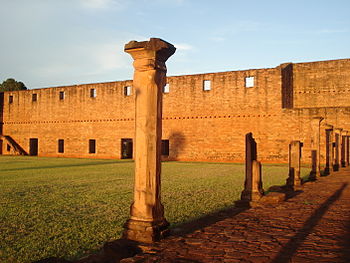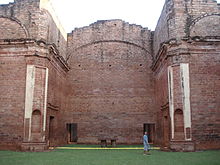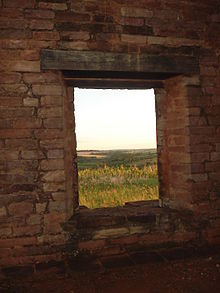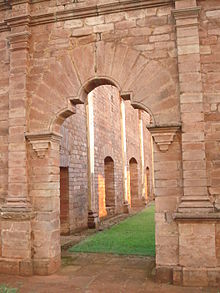- Jesús and Trinidad Jesuit Ruins
-
The Jesús and Trinidad Jesuit Ruins are located in Itapúa Department, Paraguay, and are religious mission that are sill preserved and that were founded by the Jesuit missioners during the colonization of South America in the 17th century. These religious missions were created in 1609 and developed for 150 years. Both Jesuit missions were declared Historical Patrimony of Humankind by the UNESCO in 1993.
The Jesuit Missions of Paraguay are considered some of the most impressive creations of the religious work of the Jesuit, and are testimony of the historical richness of the country.
Contents
History
Alejo García discovered Paraguay in 1524. Its development in political, economical and social matter was a slow process, scarred by armed conflicts between Spanish conquerors and natives, who fought to preserve their territory.
Until 1590 the Spanish have founded 10 cities and 40 colonies in South America. The natives were forced to be at their service (Encomienda system).
The Spanish King tried to improve their quality of life by making some decrees for their protection but it was difficult to have a real system of control to make sure they were obeyed. The system of "Encomienda" gave place to many insurrections of the natives.
It was not until the Missions were established that there was a real improvement in the living conditions of the natives.
The first Jesuits arrived in Tucumán in 1586 and in 1587, by request of the Asunción’s Bishop, Alonso Guerra that they arrived to Paraguay too.
The Jesuits started the evangelization and building of towns or Missions in the region of Misiones and Itapúa Departments in Paraguay.
The first thing they did was to form towns that were self-sufficient in the areas inhabited by the natives and a study of the Guaraní language they spoke to make a writing structure (because the Guaraní people did not write their language). The missioners not only imparted knowledge about religion, but also determined the rules of public order, culture, education and society, fact that had great influence in the later development of Paraguay. The natives, who were nomads and were not used to a structured life, founded themselves gathered in small communities in the forest. Near the Jesuit Missions were formed groups of 2000 or 3000 per town.
This group of missioners founded about 30 Missions in territories that nowadays belong to Paraguay, Brazil, Argentina and Bolivia. Many of the constructions have been preserved and the ones that got damage, rebuilt.
Jesús de Tavarangue Ruins
The church of Reducción de Jesús (Jesus’ Mission) was in the process of building in the moment that the Jesuits were expelled of Río de la Plata Province. It would have been one of the biggest churches of that time, with a central structure of 70 by 24 metres (230 by 79 ft).
It would have been a replica of the Church of Loyola, in Italy. The doors of access, three located in the front, are very impressive.
The UNESCO declared it Cultural Patrimony of Humankind in 1993. It is considered one of the most important edifications of the 30 Jesuits towns in the region.
The stone pulpit, the friezes of angels, the rose shaped carved stone in the lintels in the doors and the bell tower outstand in its architecture.
The ruins of these missions show a way of life and education marked by its own and singular style.
Santísima Trinidad del Paraná Ruins
The Santísima Trinidad del Paraná Mission is considered the biggest of all the missions. Natives that came from the missions of San Carlos (nowadays in territory of Argentina) were its founders in 1712.
This mission has the biggest built temple among all the Jesuit Missions, with an altar carved in a once piece stone. In it, is represented the persecution of the natives at that time. It has a Central Square, the town’s place of meeting and a museum, located in the old sacristy, are the sculptures and a scale model of the mission.
These ruins are being restored and maintained constantly.
It is a Cultural Patrimony of Humankind.
How to get to the Ruins
The Ruins in Paraguay are, possibly, the best preserved, and include Jesús, San Cosme, Damián and Trinidad Missions.
To get to these places it is necessary to take Route No. 6 from Encarnación. The entries to all the missions are signaled on the route.
The access to the ruins of Trinidad is located 700 meters from Route No. 6 in “km 31”, about 2 kilometers after, is the access to the ruins of Jesús de Tavarangue.
References
- La Magia de nuestra tierra. Fundación en Alianza. Asunción. 2007
- Corazonez. org
- Ricon del Vago
External links
Categories:- Spanish missions in Paraguay
- Ruins in Paraguay
- Jesuit history in Central and South America
- Tourism in Paraguay
- Spanish Colonial architecture
Wikimedia Foundation. 2010.




